
The Indomalayan realm is one of the eight biogeographic realms. It extends across most of South and Southeast Asia and into the southern parts of East Asia.

The Dipterocarpaceae are a family of 16 genera and about 695 known species of mainly tropical lowland rainforest trees. The family name, from the type genus Dipterocarpus, is derived from Greek and refers to the two-winged fruit. The largest genera are Shorea, Hopea, Dipterocarpus, and Vatica. Many are large forest-emergent species, typically reaching heights of 40–70 m, some even over 80 m, with the tallest known living specimen 93.0 m tall. The species of this family are of major importance in the timber trade. Their distribution is pantropical, from northern South America to Africa, the Seychelles, India, Indochina, Indonesia, Malaysia and Philippines. The greatest diversity of Dipterocarpaceae occurs in Borneo. Some species are now endangered as a result of overcutting, extensive illegal logging, and habitat conversion. They provide valuable woods, aromatic essential oils, balsam, and resins, and are a source for plywood.

Lithocarpus is a genus in the beech family, Fagaceae. Trees in this genus are commonly known as the stone oaks and differ from Quercus primarily because they produce insect-pollinated flowers on erect spikes and the female flowers have short styles with punctate stigmas. The World Checklist accepts 334 species, all restricted to Southeast Asia. Fossils show that Lithocarpus formerly had a wider distribution, being found in North America and Europe during the Eocene to Miocene epochs. These trees do not tolerate freezing temperatures, because all species are evergreen and none are found in temperate zones, despite the lack of any geographic barrier to dispersal in the subtropical zone of East Asia. They extend from the foothills of the Hengduan mountains, where they form dominant stands of trees, through Indochina and the Malayan Archipelago, crossing Wallace's Line and reaching Papua. In general, these trees are most dominant in the uplands and have many ecological similarities to the Dipterocarpaceae, the dominant lowland tree group. These trees are also obviously intolerant of seasonal droughts, not being found on the Lesser Sunda islands, despite their ability to cross numerous water barriers to reach Papua.
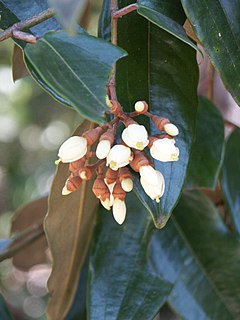
The Sarcolaenaceae are a family of flowering plants endemic to Madagascar. The family includes 79 species of mostly evergreen trees and shrubs in ten genera.
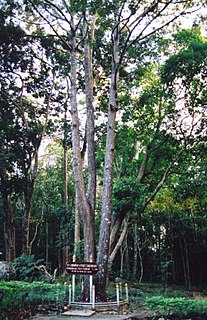
Shorea is a genus of about 196 species of mainly rainforest trees in the family Dipterocarpaceae. The genus is named after Sir John Shore, the governor-general of the British East India Company, 1793–1798. The timber of trees of the genus is sold under the common names lauan, luan, lawaan, meranti, seraya, balau, bangkirai, and Philippine mahogany.
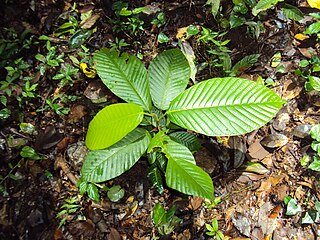
Dipterocarpus is a genus of flowering plants and the type genus of family Dipterocarpaceae.
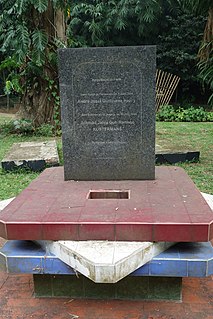
Dr. André Joseph Guillaume Henri 'Dok' Kostermans was an Indonesian botanist of Dutch ancestry. He was born in Purworejo, Java, Dutch East Indies, and educated at Utrecht University, taking his doctoral degree in 1936 with a paper on Surinamese Lauraceae.
Shorea balangeran, called red balau, is a species of plant in the family Dipterocarpaceae. It is native to Sumatra and Borneo. It is a Vulnerable species threatened by habitat loss.

Shorea contorta is a species of plant in the family Dipterocarpaceae. It is endemic to the Philippines.
Shorea negrosensis is a species of plant in the family Dipterocarpaceae. It is endemic to the Philippines.
Shorea stenoptera, called, along with some other species in the genus Shorea, light red meranti, is a species of tree in the family Dipterocarpaceae, and is endemic to Borneo. It is an Endangered species, and threatened by habitat loss.
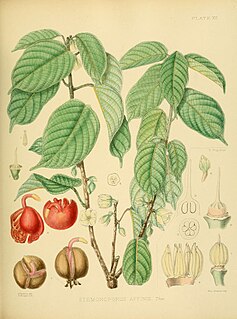
Stemonoporus is a genus of plants in the family Dipterocarpaceae.

Vatica is a genus of plants in the family Dipterocarpaceae.
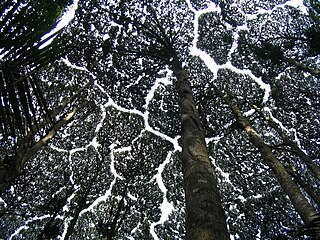
Dryobalanops is a genus of flowering plants and the genus of family Dipterocarpaceae. The name Dryobalanops is derived from Greek and describes the acorn-like nut. The genus has seven species, confined to the tropical forests of West Malesia. It is among the most abundant species of emergent trees in these forests, growing up to 80 m tall.

Anisoptera is a genus of plants in the family Dipterocarpaceae. The name Anisoptera is derived from Greek and describes the unequal fruit calyx lobes. It contains ten species distributed from Chittagong (Bangladesh) to New Guinea. Eight out of the ten species are currently listed on the IUCN redlist. Of these, four species are listed as critically endangered and the other four as endangered. The main threat is habitat loss. The timber is a light hardwood.
Marquesia is a genus of plant in family Dipterocarpaceae. It contains the following species:
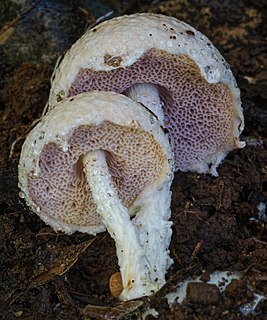
Austroboletus is a genus of fungi in the family Boletaceae. The widely distributed genus contains 28 species that form mycorrhizal relationships with plants.
Beesoniidae is a family of scale insects commonly known as beesoniids. They typically cause galls on their plant hosts. Members of this family mostly come from southern Asia. The family name comes from the type genus Beesonia which is named after the entomologist C.F.C. Beeson who obtained the specimens from which they were described and named.
Pakaraimaea is a genus of trees in the family Cistaceae.












